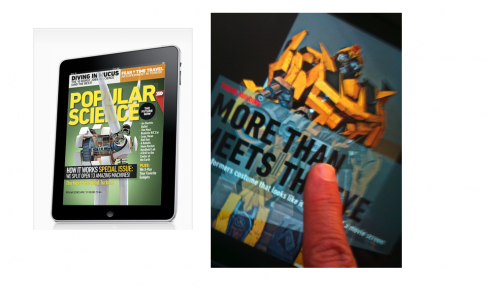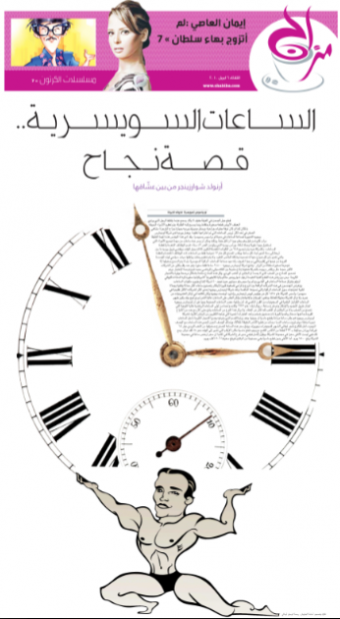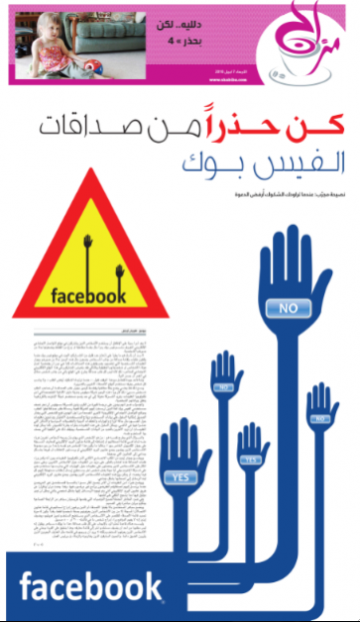TAKEAWAY: The iPad has not been around even a week, but already, I am happy to see that the discussion has moved from the amazing four-button wonder itself, to the issue of what constitutes good design for publications that go iPad, or, for that matter, tablets generally. PLUS: New Al Shabiba feature pages: the design evolves
Updated Wednesday, April 7, 16:04 EST
Interesting discussion of iPad design for news sites
http://www.niemanlab.org/2010/04/three-ipad-design-choices-that-will-influence-how-we-read-news-online/

Perhaps one of the most talked about publications on the iPad is Popular Science, and, indeed, I have received dozens of messages from people who tell me to make sure I don’t miss it. I have reviewed it, and many of the features here are quite attractive. Images take center stage, but then you click on screen, and the accompanying text comes in a sort of transparent strip. Finger up and down gives you something to read. Finger across gives you more images. The demo was quite instructional and provided users with red arrows that would guide them thru the process.
So, it was with great interest that I read Khoi Vinh’s review of the iPad, which included specific reference to Popular Science, and has become one of the first pieces I have read to address the issue of design strategy on the iPad. Vinh writes:
“…..this inaugural issue of Popular Science on the iPad, while gorgeous and impressive, is also gimmicky, repetitive and unusable. It’s a noble attempt, but it’s also a disappointment.
Vinh mentions something we all need to think about: the collision point between interaction design and traditional publication design, one in which the latter prevails.
I had drawn a similar conclusion as I read TIME Magazine’s iPad edition while flying from Miami to Frankfurt last night. I kept going from TIME to Popular Science. I am aware that these are two very different publiations: one devoted to news and features, the other a specialized journal with greater possibilities for multimedia applications.
However, in terms of their design for the iPad, TIME stuck pretty closely to its print format, at least on this inaugural iPad edition. Popular Science is quite ambitious in letting you know immediately all that the iPad can do to put wings on the printed edition.
I know that we will devote much thinking to designing for the iPad, and nobody has the answer today. We can only comment on what we see.
But the questions are going to be in my head as I download other apps, and as I discuss the issue with editors and designers in newsrooms around the world. Do you have the same questions?
Design related questions as we study the iPad
1. How much of the print edition is transferred to the iPad? Should we do a page by page, like TIME has done in this inaugural issue? I tend to say YES, because, as a reader of TIME for over 35 years, I felt very familiar with the look and feel, and the rhythm of my TIME on the iPad. However, the iPad enthusiast in me kept waiting for a little bit more of what I told my colleagues at Paris Match is the Follies Bergere moments, when the pop up book, well, pops in front of your eyes.
2. In both Popular Science and TIME, photos dominate—-not a bad thing, and I maintain that photography will play a protagonistic role in the tablets, and we have not even scratched the surface here. The question remains: is the big double page photograph that sits there waiting for a headline and text layer to land on it the answer? What else can be done with photographs? Should we use photography for more “mini storytelling” than we do in print? The examples out there this week don’t do that. I think that photos can jump from their linear and static mode into something beyond that, but what?
3. The question of flow and rhythm: I like TIME’s content bar, which allows you to jump to where you want to go at anytime, defining your own rhythm for how you read the magazine.
As we design storyboards for the iPad and other tablets, do we need to create the Follies Bergere moments here and there, but combining them with more traditional panels? Would TIME’s inaugural edition benefit from a little more movement for some of the content?
In traditional print we always talk about the importance of “destination pages” that change the rhythm and the pacing of the content, a sort of cleansing of the palate, like that sorbet between soup and salad at the restaurant. Well, in iPad land, perhaps we need to create destination moments.
I am happy to see that only five days after the iPad landed in our midst, we now are turning our attention to design and the role that it will play as we cope with how to take traditional print design elements into this new platform.
Five years from now, I can see that designing for tablets will have come into its own, with some traces of traditional print design visible and acting as a sort of foundation, but with 80% design that is precisely customized to cater to the needs of those who get all their information exclusively on a tablet. Until then, we need to study how we travel through the “transitional years” that started last Saturday when the iPads made it officially into the world.
Two links of interest
Two links on advertising on the iPad :
Good discussion of the role of ads in news apps:
http://www.niemanlab.org/2010/04/full-screen-ahead-wsj-ipad-ads-fuse-logic-of-print-online/?utm_source=feedburner&utm_medium=feed&utm_campaign=Feed:+NiemanJournalismLab+(Nieman+Journalism+Lab
Apple may be starting its own ad service
http://www.engadget.com/2010/04/06/apple-to-announce-iad-adkit-mobile-ad-platform-on-thursday/
For Al Shabiba: beyond the “sheen” and into page design
Senior designer at Al Shabiba (Muscat, Oman), Osama Aljawish, sends us his latest creations here. As readers of this blog know, we spent many days just getting to perfect the logo for this newspaper, so it is refreshing to see that now the design we created has taken off, and these feature sections show it. Design director is Adonis Durado., assisted by Nasser Othman.



Three feature pages from Al Shabiba published this week: the design begins to evolve